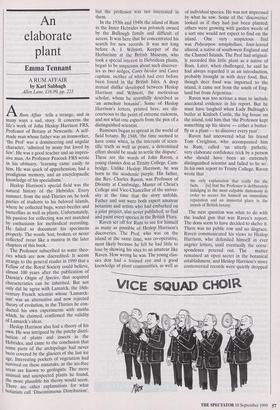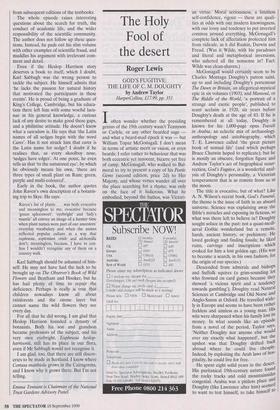An elaborate plant
Emma Tennant
A RUM AFFAIR by Karl Sabbagh Allen Lane, £16.99, pp. 223 ARum Affair tells a strange, and in many ways a sad, story. It concerns the life's work of John Heslop Harrison FRS, Professor of Botany at Newcastle. A self- made man whose father was an ironworker, `the Prof was a domineering and angular character, 'admired by many but loved by few'. He was a good teacher and an impres- sive man. As Professor Peacock FRS wrote in his obituary, 'learning came easily to him. He was quick of apprehension, had a prodigious memory, and an encyclopaedic knowledge of his specialisms.' Heslop Harrison's special field was the natural history of the Hebrides. Every summer, from the mid-Thirties on, he took parties of students to his beloved islands, where he collected bugs, water-beetles and butterflies as well as plants. Unfortunately, his passion for collecting was not matched by enthusiasm for methodical recording. He failed to document his specimens properly. The words 'lost, broken, or never collected' recur like a mantra in the later chapters of this book.
The Professor subscribed to some theo- ries which are now discredited. It seems strange to the general reader in 1999 that a Fellow of the Royal Society could believe, almost 100 years after the publication of Darwin's Origin of Species, that acquired characteristics can be inherited. But not only did he agree with Lamarck, the 18th- century French scientist whose 'Lamarck- ism' was an alternative and now rejected theory of evolution, in the Thirties he con- ducted his own experiments with moths which, he claimed, confirmed the validity of Lamarck's ideas.
Heslop Harrison also had a theory of his own. He was intrigued by the patchy distri- bution of plants and insects in the Hebrides, and came to the conclusion that some parts of the archipelago had never been covered by the glaciers of the last ice age. Interesting pockets of vegetation had survived on these nunataks, as the ice-free areas are known to geologists. The more unusual and unexpected plants he found, the more plausible his theory would seem. There are other explanations for what botanists call 'Discontinuous Distribution', but the professor was not interested in them.
In the 1930s and 1940s the island of Rum in the Inner Hebrides was privately owned by the Bullough family and difficult of access. It was here that he concentrated his search for new records. It was not long before A. J. Wilmott, Keeper of the Herbarium at the British Museum, who took a special interest in Hebridean plants, began to be suspicious about such discover- ies as two sedges, Carex bicolor and Carex capitata, neither of which had ever before been found in the British Isles. A deep mutual dislike developed between Heslop Harrison and Wilmott, the meticulous scholar, whom he scornfully described as `an armchair botanist'. Some of Heslop Harrison's letters, printed here, are dis- courteous to the point of extreme rudeness, and not what one expects from the pen of a distinguished scientist.
Rumours began to spread in the world of field botany. By 1948, 'the time seemed to have come when, in the interests of scien- tific truth as well as peace, a determined effort should be made to settle the dispute'. These are the words of John Raven, a young classics don at Trinity College, Cam- bridge. Unlike Heslop Harrison, he was born to the academic purple. His father, the Rev. Charles Raven, was Professor of Divinity at Cambridge, Master of Christ's College and Vice-Chancellor of the univer- sity at the time that the story unfolds. Father and son were both expert amateur botanists and artists who had embarked on a joint project, alas never published, to find and paint every species in the British Flora.
Raven set off for Rum to see for himself as many as possible of Heslop Harrison's discoveries. The Prof, who was on the island at the same time, was co-operative, most likely because he felt he had little to lose by showing his sites to an amateur like Raven. How wrong he was. The young clas- sics don had a trained eye and a good knowledge of plant communities, as well as of individual species. He was not impressed by what he saw. Some of the 'discoveries' looked as if they had just been planted; others were growing with garden weeds of a sort one would not expect to find on the island. One very suspicious find was Polycarpon tetraphyllum, four-leaved allseed, a native of south-west England and the Channel Islands. The Prof had original- ly recorded this little plant as a native of Rum. Later, when challenged, he said he had always regarded it as an introduction, probably brought in with deer food. But, though deer food was imported to the island, it came not from the south of Eng- land but from Argentina.
Raven was too serious a man to include anecdotal evidence in his report. But he must have laughed when Lady Bullough's butler at Kinloch Castle, the big house on the island, told him that 'the Professor kept something up his sleeve — either a butter- fly or a plant — to discover every year'.
Raven had uncovered what his friend Tom Creighton, who accompanied him to Rum, called 'an utterly pathetic, very elaborate confidence trick by a person who should have been an extremely distinguished scientist and failed to be so'. In his own report to Trinity College, Raven wrote that the only explanation that really fits the facts... [is] that the Professor is deliberately indulging in the most culpable dishonesty in order to secure for himself an immediate reputation and an immortal place in the annals of British botany.
The next question was what to do with the loaded gun that was Raven's report. The dons seem to have decided to shelve it. There was no public row and no disgrace. Raven communicated his views to Heslop Harrison, who defended himself in ever angrier letters, until eventually the corre- spondence petered out. The matter remained an open secret in the botanical establishment, and Heslop Harrison's more controversial records were quietly dropped from subsequent editions of the textbooks.
The whole episode raises interesting questions about the search for truth, the conduct of academic life, and the wider responsibility of the scientific community. The author does not follow up these ques- tions. Instead, he pads out his slim volume with other examples of scientific fraud, and muddles his argument with irrelevant com- ment and detail.
Even if the Heslop Harrison story deserves a book to itself, which I doubt, Karl Sabbagh was the wrong person to tackle the subject. He himself admits that `he lacks the passion for natural history that motivated the participants in these events'. He is proud of being a graduate of King's College, Cambridge, but his educa- tion there left him with some woeful lacu- nae in his general knowledge, a curious lack of any desire to make good these gaps, and a philistine attitude. He doesn't know what a vasculum is. He says that 'the Latin names of all sedges begin with the word Came. Has it not struck him that carex is the Latin name for sedge? I doubt if he realises that, as every skoolboy nose, `sedges have edges'. At one point, he even tells us that 'to the untutored eye', by which he obviously means his own, 'there are three types of small plant on Rum; green, purple and multi-coloured'.
Early in the book, the author quotes John Raven's own description of a botanis- ing trip to Skye. He says: Raven's list of plants . . was both evocative and meaningless to me; evocative because `green spleenwort', `eyebright' and 'lady's mantle' all convey an image of a former time when plant names were part of our ancestors' everyday vocabulary and when the names reflected popular culture in a way that euphrasia, asplenium viride and alchemilla don't; meaningless, because, I have to con- fess I wouldn't recognise any of them on a country walk.
Karl Sabbagh should be ashamed of him- self. He may not have had the luck to be brought up on The Observer's Book of Wild Flowers and Bentham and Hooker, but he has had plenty of time to repair the deficiency. Perhaps it really is true that children nowadays know all about rainforests and the ozone layer but cannot name the wild flowers they see every day.
For all that he did wrong, I am glad that Heslop Harrison founded a dynasty of botanists. Both his son and grandson became professors of the subject, and his very own eyebright, Euphrasia heslop- harrisonii, still has its place in our flora, even if Mr Sabbagh would not recognise it.
I am glad, too, that there are still discov- eries to be made in Scotland. I know where Cortusa matthiola grows in the Cairngorms, and I know why it grows there. But I'm not telling.
Emma Tennant is Chairman of the National Trust Gardens Advisory Panel.



























































































 Previous page
Previous page